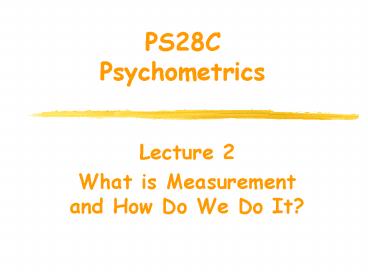PS28C Psychometrics PowerPoint PPT Presentation
1 / 24
Title: PS28C Psychometrics
1
PS28CPsychometrics
- Lecture 2
- What is Measurement and How Do We Do It?
2
Measurement
- Measurement is one of the three foundations of
psychometrics - Measurement is
- The process of assigning numbers to represent a
quantifiable difference between people - Good measures faithfully reflect differences
between people
3
Hypothetical Constructs
- A hypothetical construct is a theoretical
description of a some attribute - Exist only as abstractions
- A collection of ideas describing the properties
of an object or phenomena
4
Hypothetical Constructs
- Can be simple or complex
- Simple constructs have one or two properties
which are loosely associated - Complex constructs have many properties which are
more strongly associated
5
Hypothetical Constructs
- Basic foundation of theories
- Hypothetical constructs inform the measurement
process - Provide descriptions of the properties that your
measure should include
6
Numbers as a Language
- Numbers and mathematics are a language describing
the world in quantifiable terms - Written language preceeded numbers
- Ancient Egyptians had first simple system of
numbers
7
Numbers as a Language
- Numbers evolved from pictographs
- Mathematics developed as system to combine
numbers - Numbers are like words while mathematics is the
grammar - Numbers are intimately tied to objects in the
real world
8
Numbers as a Language
- Numbers and mathematics reflect the sensed world
but do not determine it - Mathematical models are simply a shorthand way of
describing behaviour
9
A Controversy in Psychometrics
- Clash of two different world views in
psychometrics - Hypothetical constructs are abstractions outside
of real objects - Numbers and mathematics are reflections of real
objects
10
A Controversy in Psychometrics
- Ancient dispute between Plato and Aristotle
- Plato suggests that our senses are unreliable and
we must focus on abstract properties - Aristotle suggests that our senses are reliable
and should be basis of science
11
Measurement Theory
- Most critical factor is understanding how things
differ - Differences in quality versus quantity
- Measurement systems must correctly reflect the
number of differences that truly exist
12
Levels of Measurement
- Four properties need to be addressed in
determining level of measurement - Distinctiveness
- Ordering by magnitude
- Equality of intervals
- True zero point
13
Levels of Measurement
- Four levels of measurement
- Nominal
- Ordinal
- Interval
- Ratio
- Properties and types of permissible
transformations determines level of measurement
14
Nominal Measures
- Unique numbers arbritarily assigned to distinct
objects or observations - Numbers reflect qualitative differences and not
quantitative differences - All types of mathematical changes are possible
15
Ordinal Measures
- Numbers reflect rank ordering of objects
- Reflect quantitative distinctions in order of
magnitude - Any mathematical transformation possible as long
as rank ordering preserved
16
Interval Measures
- Assignment of numbers to observations reflect
fact that differences occur at equally spaced
intervals - Possible to calculate and interpret ratios
between intervals via linear transformations
17
Interval Measures
- Permissible linear transformations follow this
form - Y aX b
- Where Y is new value
- a is a constant
- b is a constant, and
- X is the original value
18
Interval Measures
- Example
- 3 Persons with differing leadership
- Person A 10
- Person B 20
- Person C 40
- B-A20-1010 C-B40-2020
- Ratio of Differences
- C-B/B-A 40-2020
19
Interval Measures
- Y 2X 10
- Person A30
- Person B50
- Person C90
- B-A50-3020 C-B90-5040
- Ratio(C-B)/(B-A)40/202
20
Ratio Measures
- Numbers assigned to observations reflect fact
that ratios between observations are
interpretable - Have true zero point
- Only permissible form of transformation is
multiplication by a constant
21
Ratio Measures
- Permissible transformations take this form
- Y aX
- Where Y is the new scale value
- a is a constant, and
- X is the original scale value
22
Ratio Measures
- Scores on a measure of ability to play tennis
- Person A9
- Person B3
- Ratio A/B9/33
- Apply transformation of Y5X
- Y5(9)45 Y5(3)15
- Ratio A/B45/153
23
Levels of Measurement and Mathematics
- Level of measurement determines the how different
observations can be combined - At nominal level observations can not be added,
subtracted, multiplied or divided - At ordinal level observations can not be added,
subtracted, multiplied or divided - Rank ordering is only possible combination
24
Levels of Measurement and Mathematics
- At interval level observations can be added and
subtracted but not divided - At ratio level observations can be added,
subtracted, multiplied and divided

